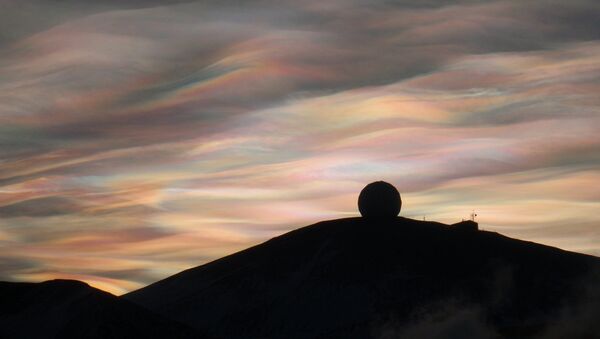Here are some stunning natural phenomena which occurred in 2016 in Russia's Far North, shared by locals through social media.
"Pearly" clouds
At the end of December, Murmansk residents were lucky to see one of the most uncommon natural phenomena — nacreous clouds. The name comes from the word from nacre, or mother of pearl, due to its iridescence.
Among scientists this incredible sight is known as PSCs, or Polar stratospheric clouds. Brightly glowing clouds with vivid iridescent colors appear from winter to spring in the polar stratosphere at altitudes of 15-27 kilometers. The phenomenon can be observed only once every 8-10 years.
Thunder and lightning in a winter snow storm
Just weeks before that, in the beginning of December, another anomaly occurred in Russia's Murmansk — thundersnow, also known as a winter thunderstorm. A proper thunderstorm with lightning hit the city; however, instead of rain, typical for such weather, there was snow falling from the sky.
According to meteorologists, thundersnow can only happen near non-freezing water bodies. The winter thunderstorm has only been seen a few times over the last two decades.
Northern lights and lightning
The people of Norilsk witnessed this unusual phenomenon in the beginning of September 2016. In terms of science, there is nothing special in the simultaneous appearance of the aurora borealis (northern lights) and lightning. However, the sight was so impressive that the locals were unable to ignore it.
"Black" storm
It's not about the color of snow but about its power of destruction. A strong northern storm, popularly known among locals as a "black" storm, hit Norilsk in March 2016. The insane storm ravaged the city, overturned heavy trucks, tore off roofs of houses and even moved a plane!
Giant ice balls
In early November, unusual ice balls were discovered on the Yamal Peninsula. Perfectly smooth, with a diameter of 30-50 centimeters, they were discovered lying very close to each other on the shore of the Gulf of Ob.
According to the Russia's Arctic and Antarctic Research Institute (AARI), such ice balls were the result of a special combination of different factors: choppy wind, coastal configuration, zero water temperature and the presence of slush, a thick layer of fine ice crystals on the surface of the water. All of this resulted in the bizarre round blocks of ice appearing on the shore.
Never miss a story again — sign up to our Telegram channel and we'll keep you up to speed!


